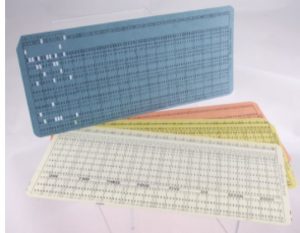History (1890): Punched Card
Also known as IBM or Hollerith card
This is a Press Release edited by StorageNewsletter.com on September 17, 2018 at 2:33 pmThis article was published by the Museum of Obsolete Media.
Punched card (1890-1980s)

Punched cards (also known as IBM cards or Hollerith cards) were used to control automated machinery or for data processing and consisted of stiff card with holes in predefined positions to represent data or commands.
Prior to their first use for data processing in the 1890 US census using cards designed by Herman Hollerith, forms of punched cards were used to control Jacquard textile looms and mechanical organs.
The cards used in the 1890 US census had round holes, 12 rows and 24 columns.
In 1928, IBM developed the 80-column card, using rectangular holes, and this doubled the data that could be stored on a card. The 80-column card became the dominant type, but other formats were available.
IBM and its competitors developed a variety of machines for creating, sorting, and tabulating punched cards and by the 1950s the punched card had become ubiquitous in industry and government. They were the primary medium for data entry, storage, and processing even before the advent of the digital computer, and millions were created every day. They were a write-once medium, and groups or ‘decks’ of cards formed programs or collections of data. Users could create cards using a desk-sized keypunch with a typewriter-like keyboard. A typing error generally necessitated repunching an entire card.
During the 1960s however, magnetic tape began to replace punched cards as the primary means for storage. Even so, punched cards were still commonly used for data entry and programming until the mid-1980s.
The first punched cards were blank, but subsequent cards usually had printing such that the row and column position of a hole could be identified, and cards could also carry other printed information such as logos. Some cards had one upper corner cut so that cards not oriented correctly, or cards with different corner cuts, could be easily identified.
A standard 80-column punched card contains 80 bytes, so 99,981 boxes of 2,000 cards would be required to contain the same amount of data as a single 16GB microSD card.













 Subscribe to our free daily newsletter
Subscribe to our free daily newsletter

